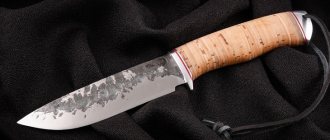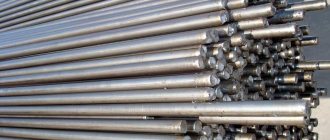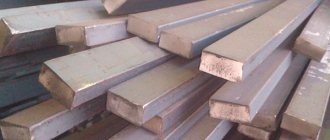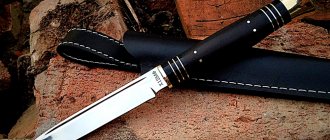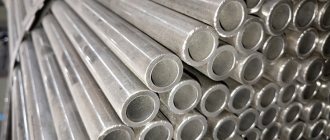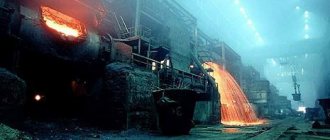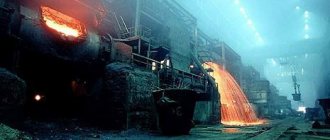Alloy Application
The given qualities of this steel determined its direct place in production. It is mainly used for cutting other materials under extremely high temperature conditions. It is much more practical to use a quick cutter for these tasks than any stainless alloys. A characteristic feature of R6M5 is its excellent edge retention due to its high hardness.
This beautiful metal also withstands shock loads very well, which makes it in demand in the manufacture of cranes, drills and reamers.
Knife blade made of R6M5 steel.
R6M5 with its properties is dynamically used for the production of knives. Due to the widespread use and production of this tool, there are many well-known manufacturers, for example, the same Rapid.
Numerous experiments are being carried out using knives made of P6M5. They are effective at cutting the following objects with increased strength: thick ropes, wood, bones, etc. The most spectacular successful test was cutting an iron plate with a knife made of P6M5, which was several mm thick - not without difficulties, but it was successful.
When P6M5 is used to make knives, it is usually hardened to HRC 60-62, although sometimes this parameter is brought to HRC 66-67.
Benchmade is one of the largest companies producing knives using P6M5 steel. This alloy is unique in its composition, it contains large amounts of molybdenum and tungsten, but the result is a very fine-grained steel, ideal for creating blades.
GOST and TU steel R6M5
Information about R6M5 steel is available simultaneously in several GOSTs and TUs. All contain products and their technological parameters. Despite the redirection of rolled metal to hard alloys, due to its properties, R6M5 is still very popular in many industries.
Characteristics of high-speed steels
High-speed alloys have appeared relatively recently. Before their appearance, ordinary steel cutters were used to turn wood or non-ferrous metal products, and some difficulties arose when using them. They had a very short service life due to rapid wear and became very hot, making work at high speeds impossible.
The problem was solved in 1858 after the production of an alloy in which tungsten and manganese were used as the main alloying additives. Over the next decades, through numerous experiments, several types of super-strong metals were obtained, which made it possible to significantly increase the speed and productivity of metal-cutting machines.
The category of high-speed steels includes a large group of alloys that contain alloying elements that make it possible to achieve resistance to wear and high heat. They are distinguished from conventional carbon alloys by their high strength index, which allows the use of tools made from them for processing hard materials.
Quick cut blade.
High-speed cutters have a number of remarkable characteristics by which they can be distinguished from other grades of steel, these include the following:
- Maintaining hardness at high temperatures , so-called hot hardness. Any objects heat up when rubbed. The temperature of a cutting tool operating at high speeds increases very quickly to high levels. When exposed to such heating, ordinary steels are subjected to tempering, which is why they lose their working properties. High-speed steel is not subjected to similar processes, since its composition allows it to withstand temperatures of up to 6000 degrees Celsius without loss of strength.
- High red resistance is a parameter of an alloy, characterized by a time period during which it is able to work at high temperatures without losing its original properties.
- Resistance to destructive processes . In addition to resistance to extreme heat, high-speed cutters must have increased mechanical properties compared to conventional metals. Tools made from such alloys, even under high pressure, do not crumble or break, due to which they are actively used for the manufacture of drills and cutters.
Decoding - what the marking symbols mean
Elements of equipment and devices have a high strength index, the material has excellent viscosity. Steel ensures long-term performance, both in product components and in blades or finished tools.
Such markings are a legacy of the Soviet era:
- The letter “P” is an indicator of high-speed steels. The expression comes from the translation of the English “rapid” - “swift”.
- The sign after “P” indicates the presence of tungsten in the composition as a percentage. For this particular metal it is in the range of 6% with minor deviations.
- This is followed by the letter “M”, indicating the presence of molybdenum in the stamp. The next indicator is the percentage of presence of the element in the total mass.
- In addition to M, high-speed steels can include the following designations in their markings: “K” - cobalt, “T” - titanium, “F” - vanadium, “C” - zirconium.
Considering the designation “P6M5”, decoding can also include other letters. If the steel was smelted by electroslag remelting, an addition appears in the form of “Ш” (Р6М5-Ш). With the introduction of the latest technologies into the production process, the following wording now appears - P6AM5. This means adding nitrogen to the overall composition.
Explanation of the markings of this alloy
The explanation of the R6M5 steel marking is as follows:
- The letter “P” means high-speed or rapid steel, since the marking was based on an abbreviation from the English word “rapid” (read in Russian as rapid), which translated means “fast”. And the number that follows this letter indicates the percentage of tungsten in this alloy. In this case it is equal to 6%, with minor deviations.
- The letter “M” indicates that this alloy contains molybdenum. And the number that follows the letter also shows the amount of its presence in the alloy of this metal as a percentage.
Example of decoding markings
If no additional elements are added to this steel, then its designation ends there. If cobalt is added to the alloy, then it will be designated P6M5K5. Marking "F" - vanadium, "T" - titanium and other additional elements.
According to GOST, R6M5 steel is divided into the following products, which belongs to one of the interstate standards. It describes all the technical requirements related to this brand. Although rolled metal has recently switched to hard alloys, this brand still maintains its leading position in market demand.
Listed below are some products made from an alloy of these metals and the corresponding GOST for them:
- hot-rolled circles belong to GOST number 2590-88;
- the calibrated rod has GOST 7417-75;
- strips and rods (for the manufacture of these products the steel variety R6M5K5 is used) - GOST 19265-73;
- wheels that have a special finish on the top layer have GOST 14955-77.
Download GOST 2590-88
Download GOST 7417-75
Chemical composition
The chemical composition of R6M5 includes, in addition to the carbon and molybdenum listed above, the following components:
- carbon (C) 0.82 – 0.90%;
- manganese (Mn) 0.20 – 0.50%;
- chromium (Cr) 3.8 – 4.4%;
- silicon (Si) 0.20 – 0.50%;
- molybdenum (Mo) 4.8 – 5.3%;
- vanadium (V) 1.7 – 2.1%;
- cobalt (Co) 0.5%;
- nickel (Ni) 0.4%;
- phosphorus (P) 0.03%;
- sulfur (S) 0.025%;
- tungsten (W) 5.5 – 6.5%.
An alloy with cobalt additives has been used since the beginning of the twentieth century. It is used to produce devices for cutting acid-resistant metals that are resistant to high temperatures. Processing such metals with devices from a different brand requires additional costs. This steel is characterized by high hardness and heat resistance.
Density of low alloy steels
The density values of the following low-alloy steels are presented: steel 15М, 12МХ, 15ХМ, 15ХФ, 30Х, 30Н3, 30ХН3, 12Х5СМА, Х6М, 30Г2, 50С2Г. The average density of low-alloy steels ranges from 7725 to 7855 kg/m3 at a temperature of 20°C. The data in the table is given depending on temperature - in the range from 0 to 1000°C. The density dimension in the table is kg/m3.
Main characteristics
The basic parameters of steel of this grade are: high toughness, excellent wear resistance, and a good level of grindability. This grade is used in the production of many types of blades and cutting equipment for working with structural strength steels.
Knife with a blade made of steel R6M5.
A tungsten-molybdenum alloy is the second name of this brand, which can retain its characteristic qualities even under extreme temperature changes. Moreover, its bending strength reaches 4700 MPa. Its combination with impact strength gives it a noticeable superiority over many of its peers.
Density of high alloy steels with special properties
The density values of the following grades of high-alloy steels are presented: steel G13, G20Kh12F, Kh21Kh15T, R18. The steel density values in the table are indicated depending on the temperature - in the range from 0 to 1100°C. Density dimension - kg/m3. Additionally, you can familiarize yourself with the table of substance densities.
Sources:
- Kazantsev E.I. Industrial furnaces. Reference manual for calculations and design.
- Brand of steels and alloys. 2nd ed., add. and corr. A. S. Zubchenko, M. M. Koloskov and others. Under the general editorship. A. S. Zubchenko - M.: Mechanical Engineering, 2003. 784 p.: ill.
Difficulties in hardening high-speed steel
Heat treatment of P6M5 contains a number of specific features associated with the characteristics of this brand, as well as a long heating time for hardening. To reach 1230 degrees Celsius (hardening temperature according to GOST), 25 percent more working time is spent than for a similar grade P18. First, a vacation period is made at 200 and 300 degrees for an hour. Further processing is carried out in 3 stages:
- 690 degrees -3 minutes;
- 860 – also 3 minutes;
- 1230 – 1.5 minutes.
Then the steel is cooled. In further processing, a three-time vacation period at 560 degrees for 1.5 hours is used. During tempering periods, the alloy is supplemented with alloying additives that form carbides, which increases the strength of the final metal. Previous annealing of steel helps eliminate high brittleness with a high strength index.
Forging a knife. Steel R6M5
Attention!!!
This homemade product is posted for informational purposes only.
The creation and use as a bladed weapon is prohibited; according to Article 223.4 of the Criminal Code of the Russian Federation, it is punishable by imprisonment for up to two years!
Hello, dear friends. Forging a knife at home is accessible to anyone, you just have to want the most important thing in all of this - 1. the material and 2. the correct heat treatment.
If you forge it from good expensive steel and harden it somehow, the knife will bend in your hands or break in the same way, and vice versa, take an ordinary piece of iron from under your feet and forge a blade from it and harden it according to all the rules, then the quality of the blade will be at the highest level. So choosing the metal is only a small part of the hard work. To forge my blades, I use only second-hand raw materials, preferably from USSR times. Nowadays there is a very large selection of ready-made steel plates, but I somehow don’t trust the sellers’ words. And metal from the times of the USSR was produced according to strict GOST standards. To forge blades, you can use a bearing, a file, a spring, drills, saw blades and much more.
For today's blade, I took a drill with a diameter of 10.5 mm on the shank with the inscription p6m5, popularly known as quick cut. The main thing before forging is to determine where the grade of steel we need is. For this, I determined on a sharpener where the steel R6M5 goes. I made a mark and somehow in the future I need to forge the blade to this mark because the shank of the drill has low quality steel.
You will need a tool
- Drill
- Bulgarian
- Horn
- Set of pliers and hammer
- Furnace for heating parts
- Grinder
You will also need Materials
- Drill from 5mm
- Wood for the handle
- Stain and oil for impregnation
- Set of tapes for Grinder
- Aluminum tube and 5 mm strip
That's all for consumables, now I'm starting to forge the blade.
Forging
R6M5 steel is popularly known to cut quickly; good steel for forging a blade takes a long time to dull and cuts well, but there are also disadvantages. The main disadvantage is that such a blade rusts from any moisture in a short time. Forging a blade from r6m5 is also not an easy task; forging temperatures are about 1000°C, and hardening is at 1100°C. All these are just little things after I saw how he holds his sharpener. And so before forging, I heated it until it turned yellow and left it to cool. After annealing, I heat it up again and, holding it in a clamp, begin to unscrew it with a gas wrench. Then I begin to heat it and forge it into a strip of the thickness and length I need. Next, I begin to forge a blade from the strip. In order not to make a mistake, having driven out the bad metal onto the blade, I began to forge, shaping the blade from the tip. Afterwards I begin to forge the slopes. I decided to forge the slopes on all sides; I want to sharpen the blade on both sides. I heat it up around 900°C. After forming an approximate wedge, I reduce the heat to a dark red color and finally forge the wedge. Now I begin to form the shank.
Well, I hardened the blade after forging, but it doesn’t polish very well. To simply remove the excess metal, I spent a lot of tape and tried it with a file, hard but really. After a couple of hours, I finally polished the slopes, adjusted the shank, and started hardening. I didn’t work especially hard because for some reason the knife seemed to be already hardened. I do the hardening by simply heating it to 1000°C and letting it cool on the furnace bricks. After cooling, I temper it at 200°C for 1.5 hours. After all the procedures, I polish the blade until it shines, but for some reason the metal does not shine at first, then turns black in the air. I haven’t tried everything and haven’t achieved mirror polish, maybe I’m doing something wrong?! I suffered a little more and decided to leave the blade shiny, but a little matte in color.
Attention!!!
This homemade product is posted for informational purposes only.
The creation and use as a bladed weapon is prohibited; according to Article 223.4 of the Criminal Code of the Russian Federation, it is punishable by imprisonment for up to two years!
Become the author of the site, publish your own articles, descriptions of homemade products and pay for the text. Read more here.
Features of steel sharpening
Any product is subject to wear, and if it is a blade, to loss of sharpness. R6M5 steel, due to its special manufacturing method and chemical composition, is difficult to sharpen.
Electrocorundum grinding wheels are not able to cope with such a problem. The blade being sharpened will remain uneven, and the cutting qualities will be far from working. Therefore, to restore a product to its factory sharpening, it must be processed on CBN wheels, which are not available at every specialized sharpening machine.
An example of proper knife sharpening.
Alloys HSS and R6M5 What is better and what is the difference?
So, when testing tools by specialists of the PRADOS LLC company at various enterprises, it was found that drills and taps from foreign companies made from HSS material are often significantly superior to similar tools made from P6M5 steel. In this case, the tested tool from both grades of material had completely identical geometry and was tested on the same equipment and on the same workpiece. At the same time, the chemical composition of both materials turned out to be very close (i.e. almost identical) when tested. What is the difference?
The fact is that today there are two main types of obtaining tools from high-speed steel.
1. This is the production of drills from high-speed steel bar material, in this case the drill is made from the bar using a series of mechanical and thermal operations. This production method is the cheapest, since in this case it is relatively easy to set up large-scale production. But this production method has a negative impact on quality. The fact is that today, when machining high-speed steel workpieces, it is not possible to ensure a fine grain size of the material, and this also negatively affects the uniformity of the grains. This leads to serious changes in the properties of the drill material and uneven mechanical properties throughout the body of the tool.
2. The second method of manufacturing high-speed steel tools is the powder metallurgy method (sintering). This method of tool manufacturing is more expensive compared to tool production due to mechanical processing. But this production method ensures a finer grain size of the material, as well as a more uniform microstructure, which ensures improved mechanical properties of the tool and its more efficient operation.
That is why, for the most optimal choice of a high-speed tool, it is necessary to focus not only on the material of the tool, but also on the method of manufacturing this tool.
If you are interested in the most optimal selection of tools, or want to conduct a comparative test of your tool made of high-speed steel with a tool made of HSS using powder metallurgy using advanced European technologies, we are ready to provide you with samples for testing purposes.


